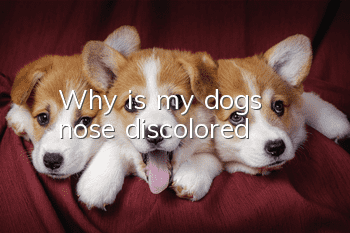Why is my dog's nose discolored?

Dogs’ noses come in many colors, including black, pink, brown or the same color as their own hair. There are many reasons for fading, some are impure populations, some are melanin deposition, some are snow nose, some are heterochromatic nose, some are caused by diseases, and some are completely normal aging process.
Affect dogs
The melanin in a dog’s nose is deposited by amino acid oxidase. This enzyme is very sensitive to temperature and has a stronger effect in a warm environment. Therefore, the dog’s nose is prone to fading in winter and returning to black in summer.
●Vitiligo
Dogs suffering from vitiligo can also cause their noses to discolor. Vitiligo is an immune system disease in dogs. Dogs with this disease will have patches of white spots on their skin, such as German Shepherds and Rottweilers. Dog breeds such as Shepherds are more likely to suffer from this disease. Diet can alleviate some of the symptoms of the disease.
●Snow nose(Snow nose)
The phenomenon of nose fading in winter is called snow nose, which is a seasonal reduction of nasal pigment. The weather is low in winter, and the nose plane is the part with the lowest body temperature, causing the color of the nose plane to become lighter. It often occurs in huskies, golden retrievers, Labradors, etc. In this case, usually not all the nasal plane will turn white, and the lips, foot pads, eyelids, paws and skin will not turn white. However, as long as the dog is in good spirits and there are no other phenomena, it will not Belongs to the category of disease.
●Contact allergy
Some dogs often come into contact with plastic rice bowls and are sensitive to plastic products, which can cause contact skin inflammation, discoloration of the nose, and even swollen lips. The solution is just to replace the plastic rice bowl with stainless steel.
●Dudley nose
The cause of heterochromatic nose may be hereditary, autoimmune or unknown. In terms of heredity, dominant circular chromosome defects are caused by huskies, Samoyeds, yellow Labradors, white German shepherds, poodles, etc. These dogs are normal at birth. - Changes begin to occur at the age of 12 months. The black part of the dog's nose gradually fades into chocolate brown or whitish color. There is no effective treatment. Some dogs will spontaneously improve or the pigment will recover, but it is only extremely rare. few.
●Reduced skin pigment
Decreased pigmentation of mucous membranes and skin is similar to snow nose and needs to be distinguished. It can cause pigment loss on the nasal plane, lips, eyelids, tongue and oral cavity. The most common dog breeds are Australian Shepherds, Huskies, Golden Retrievers and Labrador Retrievers. When the pigment is reduced, there is still enough pigment to prevent damage from sunlight. But if it completely turns into white spots, it will be very easy to cause nasal solar dermatitis. The other kind of simplicity is only inDecreased pigmentation on the lips and nose is a hereditary disease that occurs occasionally in Dobermans, Rottweilers, and other breeds. It is present at birth and the whitened area is fixed, unlike "heterochromic nose". Dogs in the mature stage are acquired.
●External damage
Dogs' noses can also turn pink if they have abrasions or scratches, or if they have experienced other illnesses or trauma. Color will return as the injury heals.
How to alleviate the fading of the dog’s nose?
Dogs should eat dog food as much as possible, supplementing vitamin B and vitamin C, trace elements iron, copper, etc. Vitamin B can help melanin deposition, while vitamin C helps vitamin B absorption. They are both water-soluble, and excess will be excreted from the body through metabolism. Seaweed powder also has a certain effect on relieving the discoloration of the nose. In addition, it can also improve the phenomenon of dogs eating daddy. Estrogen also promotes the formation of melanin and appropriately lowers food temperature.
Pet owners often feed salty things, meat, ham, canned food, etc., which will reduce the dog’s vitamin absorption over a long period of time. Their noses, skin, and paws are prone to discoloration, and eating too much salty food can easily cause them to suffer from contact allergic skin diseases.
Another thing to note is that if your dog’s nose is completely pink, you must pay attention to protecting its nose when in the sun and not allowing it to be exposed to the sun.
- What should I do if my puppy has canine distemper?
- Beginners must know: several taboos for novice dog owners!
- Can dogs eat chicken legs?
- Why does border collie nose peel?
- Will a dog heal faster if he licks his wound?
- Dog dies after making sound of water in belly
- Dog’s behavior 10 days before giving birth
- Why can't dogs enter the cemetery?
- Portal vein short circuit in dogs
- Is it a problem if the Bichon Frize has black spots on his belly?



